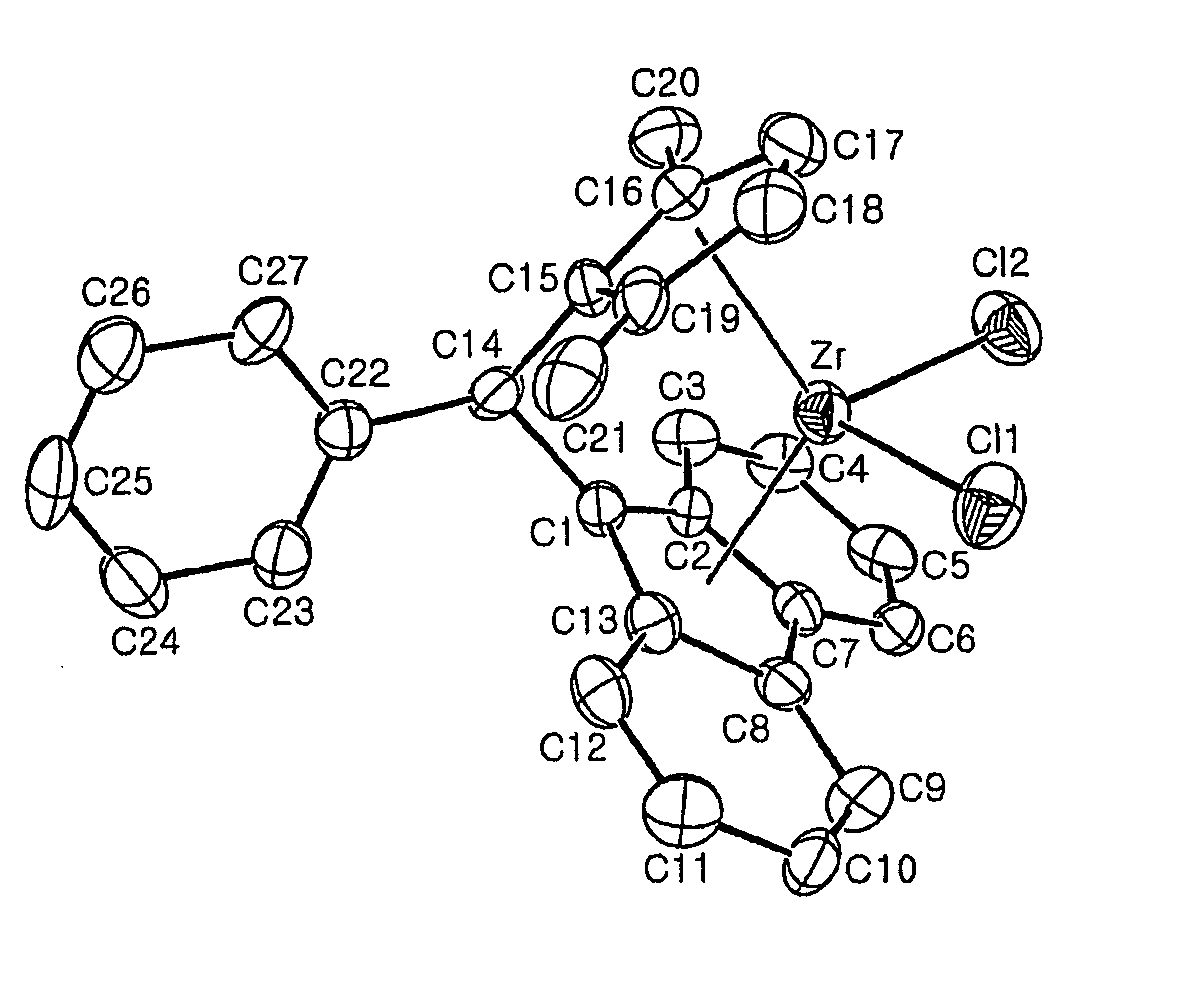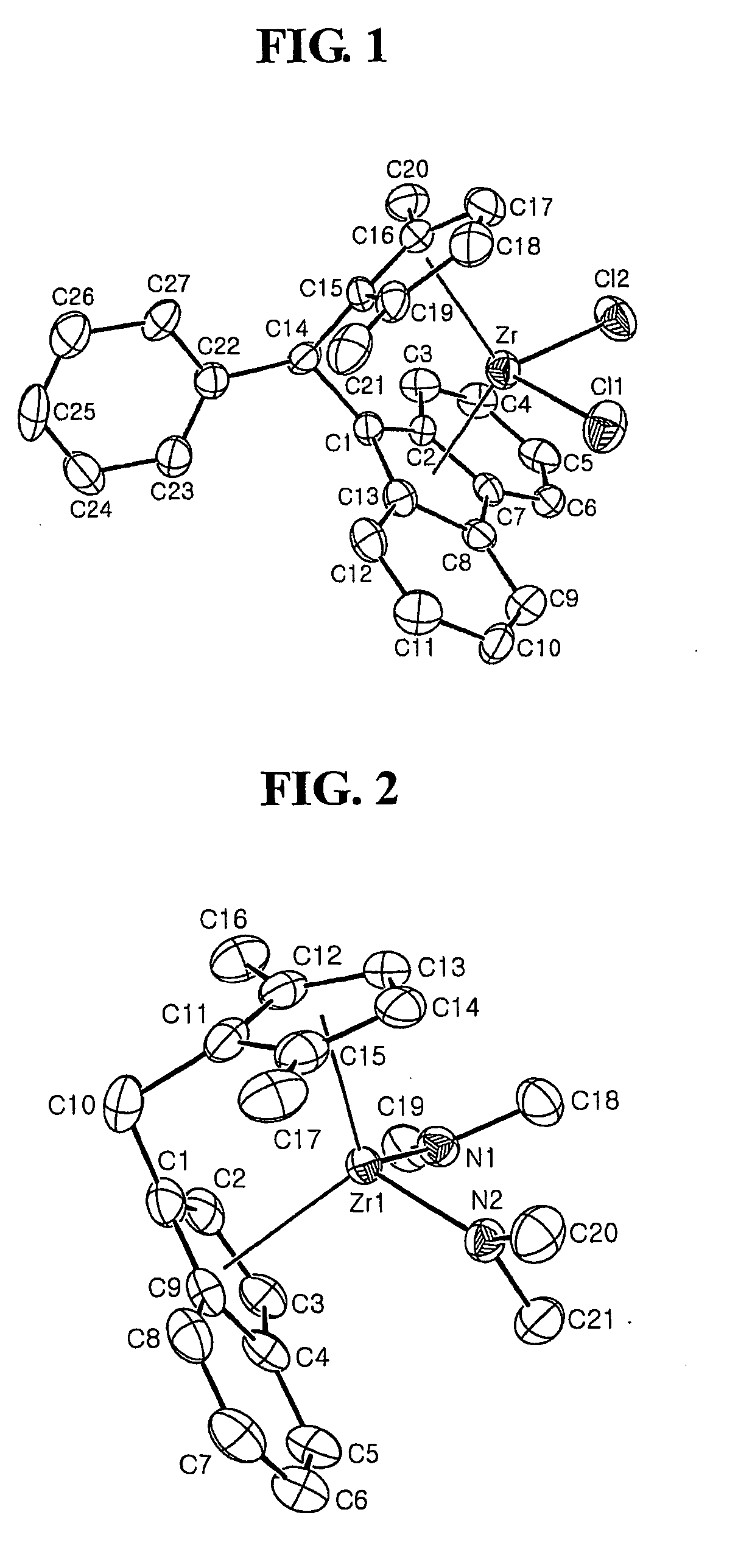Fulvene, metallocene catalysts and preparation method thereof, and preparation of polyolefines copolymer using the same
a metallocene catalyst and copolymerization technology, applied in catalyst activation/preparation, chemical/physical processes, hydrocarbons, etc., can solve the problem of insufficient electronic effect, and achieve the effect of superior copolymerization ability and polymerization activity, and little steric hindran
- Summary
- Abstract
- Description
- Claims
- Application Information
AI Technical Summary
Benefits of technology
Problems solved by technology
Method used
Image
Examples
example 1
Preparation of ketal-substituted 2-bromo-3-methyl-2-cyclopentene-1-one
From 2-bromo-3-methyl-2-cyclopenten-1-one purchased from Aldrich, ketal-substituted 2-bromo-3-methyl-2-cyclopentene-1-one was prepared according to the method reported in the literature (J. Am. Chem. Soc. 1988,110, 4741)).
example 2
Preparation of 2-(hydroxy-phenyl-methyl)3-methyl-2-cyclopentene-1-one
0.550 g (2.54 mmol) of the ketal-substituted 2-bromo-3-methyl-2-cyclopentene-1-one prepared in Example 1 was dissolved in 9.0 mL of tetrahydrofuran. Then, 1.02 mL (2.54 mmol) of 2.5M n-butyllithium was added dropwise to the solution at −78° C. The solution was reacted for 1 hour to obtain a lithium salt. 0.270 g (2.54 mmol) of benzaldehyde was slowly added to the reaction mixture, and the solution was reacted for about 1 hour at the same temperature. The reaction mixture was poured into a separatory funnel containing 10 mL of distilled water. Then, the solution was extracted with 30 mL of ethyl acetate. After removing residual moisture with anhydrous magnesium sulfate, the solvent was removed in vacuo. The obtained product, which included impurities, was separated by column chromatography eluted with a 3:1 (v / v) mixture solution of ethyl acetate and n-hexane. The obtained ketal protecting group (dioxolane group) ...
example 3
Preparation of 3-methyl-2-[phenyl-(2-tetrahydropyranyloxo)-methyl]-2-cyclopenten-1-one
0.440 g (2.17 mmol) of the 2-(hydroxy-phenyl-methyl)-3-methyl-2-cyclopentene-1-one prepared in Example 2 was dissolved in 9.0 mL of methylene chloride. After adding 0.456 g (5.43mmol) of dihydropyran at 20° C., 4.13 mg (0.0217 mmol) of p-toluenesulfonic acid monohydrate was added. Then, the solution was stirred for 2 hours. The obtained reaction mixture was diluted by adding 30 mL of ethyl acetate, and then washed with 5 mL of saturated sodium bicarbonate solution twice. The solution was separated using a separatory funnel. From the organic layer, remaining moisture was removed with magnesium sulfate, and the solvent was removed in vacuo. The obtained product, which included impurities, was separated with column chromatography eluted with a 3:1 (v / v) mixture solution of ethyl acetate and n-hexane. The yield of the obtained compound was 0.530 g (85%).
PUM
| Property | Measurement | Unit |
|---|---|---|
| Temperature | aaaaa | aaaaa |
| Time | aaaaa | aaaaa |
| Time | aaaaa | aaaaa |
Abstract
Description
Claims
Application Information
 Login to View More
Login to View More - R&D
- Intellectual Property
- Life Sciences
- Materials
- Tech Scout
- Unparalleled Data Quality
- Higher Quality Content
- 60% Fewer Hallucinations
Browse by: Latest US Patents, China's latest patents, Technical Efficacy Thesaurus, Application Domain, Technology Topic, Popular Technical Reports.
© 2025 PatSnap. All rights reserved.Legal|Privacy policy|Modern Slavery Act Transparency Statement|Sitemap|About US| Contact US: help@patsnap.com



